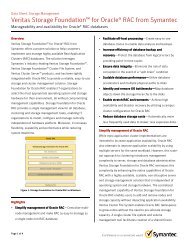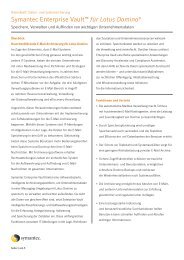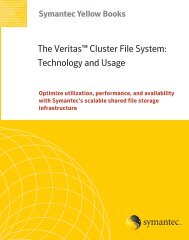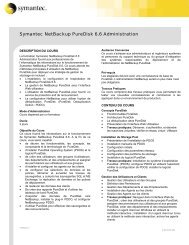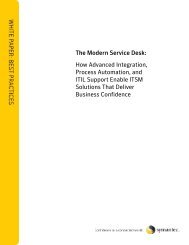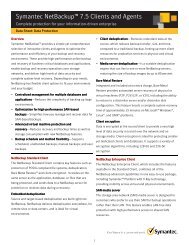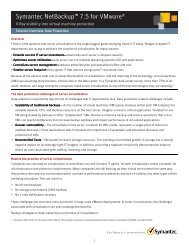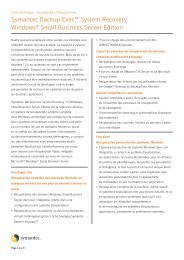xy The Numbers Don't Lie - New Page 1 [eval.symantec.com]
xy The Numbers Don't Lie - New Page 1 [eval.symantec.com]
xy The Numbers Don't Lie - New Page 1 [eval.symantec.com]
Create successful ePaper yourself
Turn your PDF publications into a flip-book with our unique Google optimized e-Paper software.
<strong>xy</strong><br />
PARTNERS<br />
<strong>The</strong> <strong>Numbers</strong> Don’t <strong>Lie</strong><br />
To cut costs, Statistics Canada adds a partner and consolidates storage<br />
It was the American author Mark<br />
Twain who, in the late 1800s,<br />
popularized the statement,<br />
“<strong>The</strong>re are three kinds of lies:<br />
<strong>Lie</strong>s, damned lies, and statistics.”<br />
More than a century later, it took just<br />
a few Canadian statisticians and a bit<br />
of technology to prove him wrong.<br />
In 2002, the Canadian<br />
government issued a nationwide<br />
directive for its agencies to reduce<br />
operating budgets. Among the<br />
agencies obliged to follow this<br />
directive was Statistics Canada<br />
(“StatsCan” for short), the<br />
organization that conducts a<br />
national census every five years. It<br />
also collects and analyzes statistics<br />
on everything from<br />
By Minda Zetlin<br />
population growth to<br />
small business performance.<br />
In response to the mandated<br />
budget cuts, Ivan Fellegi, StatsCan’s<br />
chief statistician (the equivalent of<br />
the agency’s CEO), challenged the<br />
agency to streamline operations.<br />
This challenge posed a problem<br />
for the agency’s informatics<br />
technology services department<br />
(ITSD), which was experiencing an<br />
increased need for storage.<br />
In 2001, Canada offered some<br />
citizens the choice of responding to<br />
the census over the Internet, rather<br />
than on paper.<br />
“We got 7 terabytes of data<br />
from that,” says Guy Charron,<br />
assistant director of StatsCan’s<br />
infrastructure services. In the 2006<br />
census, all 19 million Canadians<br />
old enough to respond had the<br />
option of providing their data<br />
online, and about 20 percent did<br />
so. Australia and <strong>New</strong> Zealand also<br />
offered the public the chance to<br />
respond online to a 2006 census, but<br />
40 CIO Digest January-February 2007<br />
neither country had a higher return<br />
rate than Canada, according to the<br />
U.S. Census Bureau.<br />
<strong>The</strong> new census method means<br />
huge storage needs: Charron’s team<br />
estimates it will need 50 terabytes<br />
of storage from that 20 percent<br />
census response alone. <strong>The</strong> storage<br />
will need to be long-term, as the<br />
Canadian Parliament mandates<br />
census records be kept for 92 years.<br />
StatsCan needed to increase<br />
storage dramatically while<br />
simultaneously cutting costs.<br />
Charron believed it was possible—if<br />
the agency could consolidate its<br />
data backup and storage into one<br />
stack overseen by ITSD.<br />
In 2003, StatsCan had about 100<br />
terabytes of data, most stored and<br />
managed locally by eight different<br />
operating divisions on more than<br />
750 servers. That year, ITSD<br />
conducted a total cost of ownership<br />
survey, collecting information on<br />
data storage agency-wide. <strong>The</strong><br />
survey showed that 49 percent of<br />
disk space was unutilized. Because<br />
backup and storage use was rapidly<br />
growing, it also suggested that these<br />
would be the principal drivers of<br />
future IT costs.<br />
Though ITSD had been offering<br />
centralized backup and storage as<br />
an option to all of StatsCan since<br />
1999, only 31 percent of stored<br />
data had been migrated to ITSD<br />
servers.<br />
When Fellegi<br />
challenged ITSD<br />
to streamline,<br />
Charron and his team<br />
responded with a<br />
proposal to mandate<br />
that ITSD handle all<br />
backup, storage, and<br />
Stats On<br />
Statistics Canada<br />
Founded: 1918 as the<br />
Dominion Bureau of<br />
Statistics<br />
Employees: 5,700<br />
IT staff: 1,200+<br />
s<br />
file and print services for the entire<br />
agency. “<strong>The</strong> initial business case<br />
showed savings of close to CAD 3<br />
million [about US$2.7 million] over<br />
five years,” Charron says. He knew<br />
that figure would be even greater<br />
once StatsCan was able to realize IT<br />
labor savings due to consolidation.<br />
“That’s when we started making the<br />
case that there were economies of<br />
scale.”<br />
Zero budget<br />
Controlling costs has special<br />
significance at StatsCan because<br />
ITSD operates as a pure fee-forservices<br />
division. “Unlike most<br />
other government departments,<br />
we are a <strong>com</strong>plete internal cost<br />
recovery organization,” Charron<br />
says. “Our IT budget essentially<br />
starts at zero every year. We sell<br />
our services to Statistics Canada’s<br />
various divisions.”<br />
This arrangement grew out of<br />
the agency’s desire to manage its<br />
IT costs by individual divisions—<br />
paying only for what was used<br />
rather than subsidizing the rest of<br />
StatsCan, Charron says.<br />
“<strong>The</strong> advantage is not having to<br />
go back through for funding every<br />
time we want to do something. Our<br />
rates are set on consumption by<br />
users. Want to lower IT costs? Use<br />
less. Want more? Here tit is.”<br />
Another result: efficiency. “I<br />
think we’re a very lean shop,”<br />
Charron says. “I’ve<br />
looked at what others<br />
are charging for<br />
the same services<br />
in private industry.<br />
Strictly from a cost<br />
perspective, we are<br />
much cheaper. We
PATRICK FORDHAM<br />
could not outsource at anywhere<br />
near what we are delivering the<br />
service for internally.”<br />
Any major change—such as<br />
storage consolidation—requires<br />
buy-in from internal customers.<br />
Before making its case to senior<br />
management, ITSD recruited<br />
IT experts from StatsCan’s<br />
eight fields to help <strong>eval</strong>uate the<br />
benefits of centralized storage.<br />
“We set up multiple<br />
sub<strong>com</strong>mittees,” Charron<br />
says. “One looked at storage,<br />
one at backups, one at the file<br />
and print environment. IT<br />
representatives from the client<br />
areas participated in developing<br />
the numbers sent to senior<br />
management. When clients<br />
are involved in the process, it’s<br />
hard for them to disagree on the<br />
decision afterward.”<br />
“<strong>The</strong> <strong>com</strong>mittees had<br />
membership from across<br />
Statistics Canada,” notes<br />
Gary Roberge, who served<br />
on two <strong>com</strong>mittees as an<br />
IT representative from the<br />
transportation division. (He has<br />
since switched to ITSD, where<br />
he is chief of regional offices,<br />
IT and Intel server support<br />
services.) “It was a pretty<br />
hard sell when all this came<br />
down. StatsCan has about 65<br />
divisions, and most have their<br />
own small IT shops. <strong>The</strong>re<br />
was some reluctance and<br />
skepticism in moving from a<br />
stovepiped environment to a<br />
more centralized model. But<br />
once the business case was put<br />
on the table, it became clear that<br />
centralization was something<br />
we could not afford to pass up.”<br />
In addition to the savings,<br />
consolidated storage offered<br />
protections that weren’t<br />
accessible to the divisions<br />
before. “If you asked if they<br />
had a disaster recovery plan,<br />
they’d say, ‘No, because it’s too<br />
expensive,’” Roberge notes.<br />
Though consolidating storage<br />
meant giving up some direct<br />
control, it also meant a less<br />
uncertain future.<br />
Guy Charron, Assistant Director Infrastructure Services, Statistics Canada, with TeraMach Account<br />
Executive Jeff Clarke<br />
“We showed we could<br />
achieve much lower cost in<br />
our enterprise solution,”<br />
Charron says. “<strong>The</strong>n we<br />
factored in nontangibles, such<br />
as availability and disaster<br />
recovery that we bundled with<br />
our service. It was clear that<br />
consolidation would provide<br />
a great value. It was only<br />
after we showed them these<br />
numbers that we got very senior<br />
management buy-in.”<br />
Migration mandate<br />
Buy-in meant ITSD got the<br />
mandate it was seeking: In<br />
January 2004, the corporate<br />
planning <strong>com</strong>mittee chaired<br />
by Fellegi decreed that the 69<br />
percent of stored data still in<br />
servers among the agency’s<br />
field operations would migrate<br />
to central storage. TeraMach<br />
Technologies Inc., an Ottawabased<br />
Symantec partner,<br />
helped ITSD select appropriate<br />
hardware and software.<br />
Working with TeraMach,<br />
ITSD first centralized<br />
StatsCan’s storage and backup<br />
environments into a three-tier<br />
system that lets data be placed<br />
on storage resources that align<br />
with the value of the data to the<br />
organization. In addition to the<br />
cost savings from consolidation,<br />
the system is intended to<br />
provide additional savings by<br />
storing older, less essential<br />
data on more cost-effective, less<br />
accessible systems. <strong>The</strong> tiered<br />
system consists of fibre disks for<br />
Tier 1, serial ATA disks for Tier<br />
2, and tape for Tier 3.<br />
Implementation of the tiered<br />
system is still underway, but the<br />
benefits of consolidation are<br />
already substantial—and greater<br />
than the CAD 3 million (about<br />
US $2.7 million) ITSD originally<br />
projected. Centralized storage<br />
on Veritas NetBackup Enterprise<br />
Server allows for backup and<br />
recovery cost avoidance of<br />
nearly CAD 9 million (about<br />
US$8 million). “Standardization<br />
of enterprise software tools<br />
such as Symantec NetBackup,<br />
CommandCentral, Enterprise<br />
Vault, and Storage Foundation<br />
Suite enabled the department to<br />
<strong>symantec</strong>.<strong>com</strong>/ciodigest 41<br />
<strong>xy</strong>
<strong>xy</strong><br />
PARTNERS<br />
True Partners<br />
For Statistics Canada (StatsCan), a big advantage to its relationship<br />
with Symantec partner, TeraMach is cost: TeraMach’s<br />
consulting services offer substantial savings over other options.<br />
This is a priority for the agency’s informatics technology services<br />
department, which operates on a purely fee-for-services basis.<br />
TeraMach focuses on four areas: storage, optimization, security, and<br />
availability. Jeff Clarke, a TeraMach account executive, believes the<br />
<strong>com</strong>pany has be<strong>com</strong>e a trusted advisor to StatsCan in these areas.<br />
TeraMach can also help StatsCan select products that best<br />
fit its needs. “<strong>The</strong>y keep themselves aware of our direction, our<br />
requirements, and our constraints,” says Guy Charron, assistant<br />
director of StatsCan’s infrastructure services. “And they’ve often<br />
helped us get the best value.”<br />
lower overall cost of operations,”<br />
says Jeff Clarke, a TeraMach<br />
account executive.<br />
In addition to hardware and<br />
software savings, ITSD estimates<br />
that centralization will save nearly<br />
CAD 3 million (about US$2.7<br />
million) in IT operating costs.<br />
Achieving these savings will take<br />
time due to StatsCan’s no-layoffs<br />
policy. ITSD is implementing<br />
consolidation gradually. <strong>The</strong><br />
departments will transfer data to<br />
central storage from 2004–2008, a<br />
range of time chosen because four<br />
years is the life cycle of a server.<br />
“Because of that methodical<br />
approach, we are able to absorb<br />
people through retirement,<br />
through redeployment, and<br />
through absorbing some of the fulltime<br />
employees in client areas into<br />
the central IT division,” Charron<br />
says. “We’ve had no layoffs.”<br />
Without consolidation, StatsCan<br />
would have had to increase IT staff<br />
to deal with growing storage needs.<br />
“Beyond the census, they have<br />
many other surveys that require<br />
additional storage resources,” Clarke<br />
says. “For example, the labor force<br />
survey, the small business survey,<br />
tax data, etc. All this increases<br />
storage costs on an ongoing basis,<br />
but the tools they have implemented<br />
enable their IT staff to do more with<br />
less.” In fact, ITSD was able to add<br />
100 terabytes of storage with only<br />
one additional full-time employee.<br />
42 CIO Digest January-February 2007<br />
Creating storage policies<br />
StatsCan’s next step is moving data<br />
into the three-tier storage system.<br />
“Phase one was installation of<br />
CommandCentral to understand<br />
what our holdings are,” Charron says.<br />
Determining storage policies has<br />
been hard. At issue is how long each<br />
type of data should reside in Tier-1<br />
storage, when it should be moved<br />
to Tier 2, when it should be moved<br />
to Tier 3, and whether and when it<br />
should be deleted. Because StatsCan<br />
is a government agency, it must also<br />
consider legal restrictions on the<br />
confidentiality of data and how long<br />
it should be stored.<br />
Once policies are determined,<br />
TeraMach will work with StatsCan<br />
to install Veritas Enterprise Vault<br />
software for storing unstructured<br />
data such as email so it can be<br />
moved to Tier-2 and Tier-3 storage.<br />
Charron and his team plan to<br />
re<strong>com</strong>mend moving email from<br />
Tier 1 to Tier 2 if it hasn’t been<br />
accessed in 60 days, and to tier 3<br />
if it hasn’t been accessed in 120<br />
days. “We did a data classification<br />
exercise in March of 2005,”<br />
Charron says. “We found that 62<br />
percent of all files over eight weeks<br />
old had never been accessed or<br />
modified again.”<br />
<strong>The</strong> process may be gradual;<br />
a recent Symantec report shows<br />
that 75 to 80 percent of StatsCan’s<br />
Microsoft Exchange files have not<br />
been accessed in more than a year.<br />
To keep the migration manageable,<br />
ITSD may begin by transferring<br />
two-year-old data, then one-yearold,<br />
and so on, working its way<br />
down to the 60/120-day threshold.<br />
ITSD is establishing policies<br />
by working with <strong>com</strong>mittees that<br />
include representatives from the<br />
agency’s fields. “We should see<br />
some progress in the next 12 to 18<br />
months,” Charron says.<br />
Ultimately, all of these projects<br />
are part of a master plan. “It’s our<br />
quest to implement information<br />
life cycle management from<br />
cradle to grave,” Charron says.<br />
“One of our starting steps was to<br />
consolidate storage, and that’s<br />
nearly done. We’ve addressed<br />
the infrastructure layer and the<br />
operational layer, with regards<br />
to centralized storage and<br />
backups. Now we’re addressing<br />
the management layer and the<br />
policy layer as we classify data<br />
and prepare to implement the data<br />
movers to move data from Tier 1<br />
to Tier 2 and Tier 3. Symantec will<br />
play a big role in that.”<br />
According to Clarke, the same<br />
information life cycle strategy<br />
and use of the same technologies<br />
could work equally well for any<br />
large organization. “One of the<br />
lessons from this project is that<br />
backup and storage are areas<br />
where corporations or government<br />
agencies can lower their total costof-ownership.<br />
<strong>The</strong>se changes are<br />
not that difficult to implement.<br />
<strong>The</strong>re are pretty great savings that<br />
can be achieved in a short period<br />
of time by focusing on the right<br />
areas and using the right resources<br />
to implement them. <strong>The</strong>re isn’t<br />
a single customer that couldn’t<br />
benefit from using the technologies<br />
Statistics Canada used.” n<br />
Minda Zetlin is a business technology<br />
writer in Woodstock, <strong>New</strong> York, and<br />
a contributor to Computerworld and<br />
EContent.<br />
s<br />
Read Online:<br />
www.<strong>symantec</strong>.<strong>com</strong>/ciodigest/<br />
statscan


![xy The Numbers Don't Lie - New Page 1 [eval.symantec.com]](https://img.yumpu.com/11769670/1/500x640/xy-the-numbers-dont-lie-new-page-1-evalsymanteccom.jpg)
